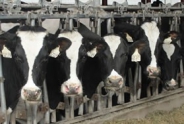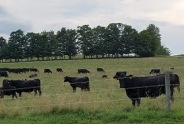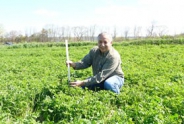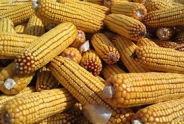When Planting Goes Wrong...
Kevin Ganoe, Area Field Crop Specialist
Central New York Dairy and Field Crops
Crop insurance can help your farm recover from a crop failure. Did you know it an also help you manage risk at planting time? Most crop insurance polices include provisions that can compensate you if you are unable to plant or help you afford to replant your crop if necessary
Prevented Planting
Prevented planting provisions in insurance policies can provide valuable coverage when extreme weather conditions prevent or delay planting.
Am I covered?
Most policies include a provision for prevented planting with the exception of group risk (GRP, GRiP, and ARPI) and catastrophic- level ("CAT") policies.
You may be eligible to file a claim if:
- Your acreage is physically available for planting
- Your acreage was planted in at least 1 of the 4 most recent crop years
- An insured cause of loss occurred within the insurance period, for example;
- Excessively wet conditions throughout the growing season which prevented nearby producers from planting similar acreage
- A specific event, like flooding, which impacted only your field
- You were unable to plant by the final planting date or during the late planting period (generally 25 days after the final planting date but varies)
You must provide notice that you were prevented from planting an insured crop within 72 hours after you determine you will be unable to plant. Then you may choose to:
- Leave the acreage idle or plant a cover crop (and receive a full prevented planting payment as long as you do not hay or graze the cover crop before November 1)
- Plant the crop late (your original production guarantee applies but is reduced one percent per day for each day planting is delayed after the final planting date), OR
- Plant a second crop (you may receive a prevented planting payment equal to 35% of the prevented planting guarantee).
Payments
The prevented planting guarantee for most crops is typically 60% of the production guarantee purchased for timely planted acreage. Some policies have additional coverage options available.
Replant
Replant provisions in insurance policies provide a payment to help producers replant after extreme weather destroys a planting.
Am I covered?
Most policies include a replant provision with the exception of group risk (GRP, GRiP, and ARPI) and catastrophic-level ("CAT") policies.
The acres to be replanted must be:
- Originally planted on or after the earliest planting date
- Either at least 20 acres total or 20% of the insured planted acreage (whichever is less-this is known as the "20/20 Rule")
- Affected by an insured cause of loss such as a late frost
- Appraised as having an expected yield below 90% of the guaranteed yield in your policy
- Determined to be "practical to replant" by an Authorized Crop Insurance Adjuster
- Replanted with the original crop.
- Notify your crop insurance agent within 72 hours
- An adjuster will appraise your expected yield and whether it is practical to replant
- If applicable replant the original crop
- Your original planting guarantee will continue as if nothing had happened (as long as you plant before the final planting date)
Payments
The replant payment is typically equal to the lesser of either your actual costs of replanting or a formula provided in your crop insurance policy provisions (for example: for corn, the per-acre replant payment equals the projected price/bushelx8 bushels).
Cornell University delivers crop insurance education in New York State in partnership with the USDA Risk Management Agency. Diversity and Inclusion are a part of Cornell University's heritage. We are an employer and educator recognized for valuing AA/EEO, Protected Veterans, and Individuals with Disabilities.
Upcoming Events
Fresh Cow Health Disorders - Spanish
July 19, 2024
July 26, 2024
August 2, 2024
August 9, 2024
August 16, 2024
August 23, 2024
August 30, 2024
Free webinar series in Spanish.
Calving Workshop
August 6, 2024 : Calving Workshop
Herkimer, NY
English / Spanish program. Limited to 8 English speaking & 8 Spanish speaking participants. Lunch included.
Announcements
Document and Share Storm Damage
Mother nature has really been difficult over the last few days. Significant damage has been seen throughout NYS. Please let us know what types of damage your farm may have sustained during this time. This could be in the form of property damage, lost power, milk dump due to lost power, loss of livestock, loss of stored feed or growing crops.Farms are encouraged to DOCUMENT AND SHARE any impacts the weather may have had on their home or business. This could include structure damage, crop loss, inventory loss due to power outages, damage to equipment or fencing, and more.
If your farm experienced any sort of damage, please reach out to any of the folks listed below (or all of them). The more impact information that is collected, the greater the likelihood of a disaster declaration which can bring vital emergency support and awareness. The CNYDLFC Team will continue to collect detail and submit to NYSDAM and the EDEN network.
Reporting Weather Related Impacts (For your home or farm business)
- First, ensure that all the people and animals on your farm are safe, and that there aren't any unsafe working conditions created because of the weather (check your structures!). If there's an emergency, call 911 - don't try to manage it all on your own.
- Second, document all negative weather impacts for your farm and their estimated financial cost. Take photos, make estimates, and put it all in a safe place.
- Reach out to your insurance providers - farm, vehicle, crop, etc. to initiate the claim process as needed.
- Then, share your farm's damage with any (or all) of the ag support agencies listed below. We all work together to collect storm damage information and funnel it up to Ag and Markets which can initiate a natural disaster declaration.
- Chenango: 607-334-5841
- Fulton/Montgomery: 518-853-2135
- Herkimer: 315-866-7920
- Madison: 315-684-3001
- Otsego: 607-547-2536
- Schoharie: 518-234-4303
- Saratoga: 518-885-8995
- Nicole Tommell: 315-861-6001
- Erik Smith: 315-219-7786
- Daniela Gonzalez: 315-749-3486
- Ashley McFarland- 315-604-2156
Your county USDA/FSA service center.
- Chenango: 607-334-3231
- Fulton/Montgomery: 518-853-4015
- Herkimer: 315-866-2520
- Madison:315-824-9076
- Otsego: 607-547-8131
- Schoharie: 518-295-8600
- Saratoga: 518-692-9940
Your county farm bureau manager
- Region 3: Bailey Coon: 518-937-0566
- Region 5: John Wagner: 315-761-9770
- Region 6: Natally Batiston: 518-937-0269
- Region 7: Todd Heyn: 518-431-9338
Please let us know how we can help you.
Cash Rent and Custom Harvest Survey
To date, there is limited information available about rental rates and fees for crop harvesting. Farms can use this valuable information for their farm business planning to help improve decision making and profitability.Farmers Can Join MeatSuite For Free!
MeatSuite.com is a free resource provided by Cornell University where NY meat farmers can create a farm profile and list their bulk (wholes, halves, quarters) and bundled (i.e. Grilling Bundle) meat products.Why should farmers join?
1. It's free and easy!
2. Connect with more local customers. In the past year the MeatSuite.com farm directory had 8,300 visits from New York consumers. Farm profiles get as many as 25 views per month from potential local customers. We also spotlight MeatSuite farms on social media and bring attention and purchases to farms through highlights and giveaways.
How do I join?
Farmers can visit https://www.meatsuite.com/farmers/ to create a free farm profile. You must list at least one product for your farm's profile to go live. You'll also have access to Cornell's free Meat Price Calculator, a helpful tool for pricing your meat to make a profit.
While you're on MeatSuite, check out the "Creating Consumer-Friendly Bulk Meats" publication on the log-in page. It has tips on how to create bulk meat products that are easier for first-time buyers to say "yes" to.
If you have any questions as you create your farm profile or products, we're here to help! Please email Matt LeRoux at mnl28@cornell.edu.




